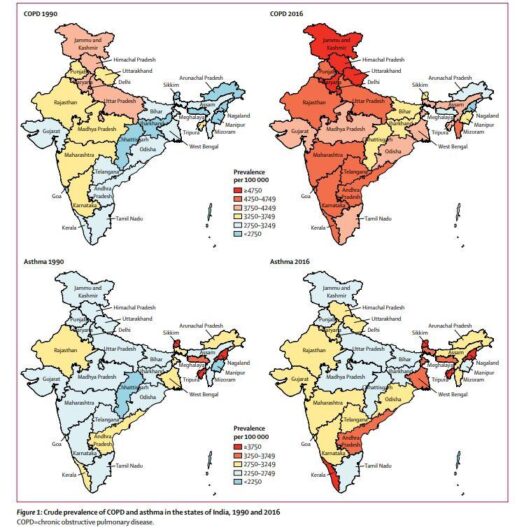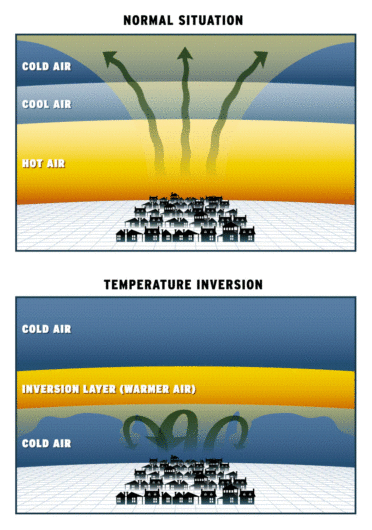The magnificent valley of Kashmir is a popular tourist destination in India and is regarded as having a pure and pristine environment. Lamentably, this side of the story lives no more to be narrated with jocundity. Presently 12,541,302 individuals in Jammu and Kashmir are inhaling air that is harmful and does not comply with World Health Organization standards for clean air. Defying the national trend of shrinking sales of automobile companies all across the country, Jammu and Kashmir emerged one among 5 other states (Manipur, Mizoram, Nagaland, and Sikkim) with improved sales of automobiles from 4.43% to 8.84% in FY19.
As per the reports from the ARTO office in Srinagar, from 2014-15 to 2022 the number of commercial and private vehicles in Jammu and Kashmir has doubled, reaching 24 lakhs. These vehicles are responsible for emitting some major air pollutants into the air in Jammu and Kashmir which include PM2.5, PM10, CO, Ozone, and NO2. The updated guidelines state that annual average concentrations of PM2.5 should not exceed 5 µg/m3, while 24-hour average exposures should not exceed 15 µg/m3 more than 3-4 days per year. Currently, the current concentration of PM2.5 in Srinagar is 23 (µg/m³), 0.92 times the recommended limit.
Particulate matter (PM) in the air is a complex combination of many different types of pollutants. It’s a complicated aerosol that combines solids and liquids in the form of tiny droplets of liquid, dry solid fragments, and solid cores coated in liquid. For the purposes of regulating air quality, particles are characterized by their diameter. Particles with a diameter of 2.5 microns or less are considered fine particulate matter (PM2.5) while particles with a diameter of 10 microns are recognized as PM10.
PM2.5 and PM10, mostly caused by emissions from the burning of fossil fuels including gasoline, oil, diesel, and wood may be inhaled into the lungs and have negative effects on human health. While PM2.5 and PM10 are also inhalable, the deposition of these particles in the lung varies with particle size. Compared to PM10, which is more likely to settle on the bigger airways in the top lobes of the lungs, PM2.5 is more likely to enter the deeper lobes. Tissue damage and inflammation in the lungs may be caused by inhaled particles.
When fuels like coal, oil, gas, or diesel are burnt at high temperatures, they release nitrogen oxide (NO2). Particle pollution and the chemical processes that produce ozone are both exacerbated by NO2 and other nitrogen oxides in the outdoor air. It’s one of the six most common air pollutants, and the national government has set guidelines to reduce its presence in the atmosphere. When fossil fuels like wood or natural gas are used in the home, nitrogen dioxide is also produced.
Air quality in Srinagar city has deteriorated mainly due to vehicular emission, road dust, and dust emitted from other developmental activities like construction and demolition of buildings, construction of flyovers, bridges, and repairing of roads. The higher levels of PM 10 and PM 2.5 are mainly due to the following reasons: i. Vehicular emission from traffic load – major concern. ii. Construction activities like flyovers, widening of roads, etc within the city, and the traffic diversions resulting in massive traffic jams due to construction of flyovers, etc. iii. The bad condition of roads and road dust. iv. Burning of biomass waste and municipal solid waste. v. Other activities i.e. D.G. sets, adulterated fuel, etc.
Health consequences of air pollution
Chronic obstructive pulmonary disease (COPD) and other lung disorders have been related to long-term exposure to these airborne respiratory irritants responsible for chronic inflammation of the lungs and making it hard to breathe. According to a study by Pati and Suliankatchi (2018), the prevalence of chronic obstructive pulmonary disease (COPD) is rising fastest in J&K, with air pollution as a major cause of chronic obstructive pulmonary disease, affecting about 4,750 out of every 100,000 persons in J&K.

The chest disease cases increase severely in winter in J&K due to the reason of colder air trapping more pollutants near the surface. As the general rule is that cooler air sinks and warmer air rises. Typically, cooler temperatures might be expected further up (how far up you are from the ground). Because of this, polluted air close to the earth’s surface may be easily dispersed as it rises. Winter is when thermal inversions are most common. Because of the reduced strength of the sun at this time of year, the air close to the earth’s surface may become cooler than the air above it, leading to the top layer of air acting as a ‘lid’ and trapping the colder, polluted air below it (Figure 2). In general, the health risks associated with breathing in polluted air during the winter are amplified by thermal inversions.
Another reason winter has higher pollution levels is because the air is less humid. Precipitation is less likely when the air is cold because the molecules in the air can’t hold as much water as those in warm air. The rain washes away pollutants and prevents thermal inversions by mixing up the layers of air, so the lack of it is problematic. Air pollution is worse in the winter because of the decreased frequency of thunderstorms, which have the potential to break up ozone.
Moreover, according to a study from Harvard T.H. Chan School of Public Health the increased mortality risk from COVID-19 infection is attributable to the preexisting medical conditions that emerged from breathing the polluted air. More cases of the COVID-19 virus were found in areas with elevated concentrations of PM 2.5 and NO2 in a recent study by Pansini and Fornacca who analyzed the spatial characteristics of the infection in eight countries (Italy, Spain, Germany, France, the United Kingdom, the United States, Iran, and China). Air quality index (AQI) was shown to be significantly correlated with the incidence of COVID-19 in Wuhan (p < 0.05) and Xiao Gan (p < 0.01) in China, according to a similar retrospective investigation by Li et al.
The authors found that PM 2.5 and NO2 were the most substantially connected with the occurrence of COVID-19 out of the four ambient air pollutants studied (PM 2.5, PM 10, NO2, and CO). Dutch researchers who pooled data from 355 different towns in the Netherlands found that PM2.5 was a very significant predictor of COVID-19 cases as well as hospital admissions. It also found that a 20% rise in pollution levels led to a nearly 100% increase in COVID-19 cases.
These studies from different corners of the world are significant enough to demonstrate how breathing poor air quality can make an individual easily fall prey to fatality rates from pulmonary viral outbreaks. Being part of the world’s highest populated region where privileges of good healthcare facilities are not everybody’s part and parcel of life, it becomes an obligation for every citizen to play their part in serving Mother Nature in order to deter future pandemics. Only a healthy body is condonable to maladies.

Figure 2: Colder air close to the earth’s surface traps pollutants causing health risks.
Ways to improve air quality
Dealing With Traffic and Vehicle Emissions: Reducing the numbers of automobile traffic and the use of cleaner vehicles is the best course of action for cutting down on emissions locally. Also, don’t let your engine idle, and make sure it’s properly tuned.
Dealing With Industrial Emissions: Regulation policies by environmental agencies are required to regulate industrial emissions.
Eco-friendly transportation: Cut down on your driving by opting for carpooling, public transit, cycling, or footing and all this could reduce air pollution.
Renewable fuel and clean energy production: Moving away from fossil fuels, and replacing them with alternative energies like solar, wind, and geothermal is the most basic solution for air pollution.
Establishment of Policies and Clean Air Action Plans: Local, national, and international environmental protection agencies need to work hand in hand to ensure the set air quality levels are met through an effective environmental action plan, strategies, and policies.
People in any nation tend to focus more on their rights than their responsibilities as citizens. Even our simple and moderate efforts may go a long way toward reducing the risks of air pollution-related chronic illnesses for ourselves and our communities. These are a few examples of crucial things you should do as a law-abiding citizen. Pollutants have the potential to negatively impact the health of everyone, even otherwise healthy individuals, although some people may be more susceptible than others. You can plan outdoor activities better based on the Air Quality Index (AQI) by downloading the app on your mobile phone. Do everything you can to limit your exposure to harmful levels of air pollution when you learn that the Air Quality Index (AQI) is high.
You must use an air purifier or fresh air machine at home or office indoors and close all the doors, windows, and ventilations when the outdoor Air Quality Index (AQI) is very high. Proper ventilation is highly recommended only when outdoor air quality is improving and moderate AQI range. Choose something that can’t influence you quite as much. Include extra rest stops within your outdoor routine. Unless absolutely necessary, postpone plans until the morning or another day.
References
Pati, Sanghamitra & Suliankatchi, Rizwan. (2018). The burden of chronic respiratory diseases and their heterogeneity across the states of India: the Global Burden of Disease Study 1990-2016 India State-Level Disease Burden Initiative CRD Collaborators*. The Lancet Global Health. 6. 10.1016/S2214-109X(18)30409-1.
Pansini R, Fornacca D. Higher virulence of COVID-19 in the air-polluted regions of eight severely affected countries. Epidemiology. (2020). doi: 10.1101/2020.04.30.20086496
Li H, Xu X-L, Dai D-W, Huang Z-Y, Ma Z, Guan Y-J. Air pollution and temperature are associated with increased COVID-19 incidence: a time series study. Int J Infect Dis. (2020) 97:278–82. doi: 10.1016/j.ijid.2020.05.076
Andree BPJ. Incidence of COVID-19 and connections with air pollution exposure: evidence from the Netherlands. Epidemiology. (2020). doi: 10.1101/2020.04.27.20081562





Leave a Reply
You must belogged in to post a comment.